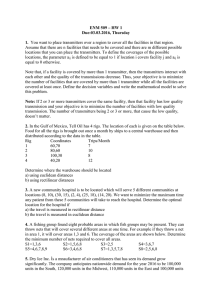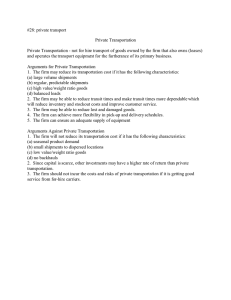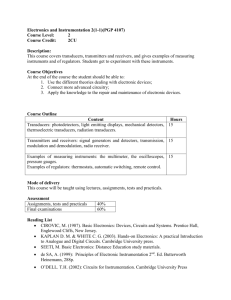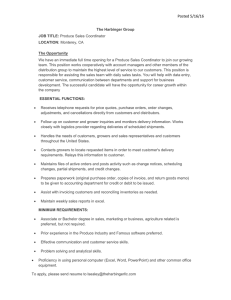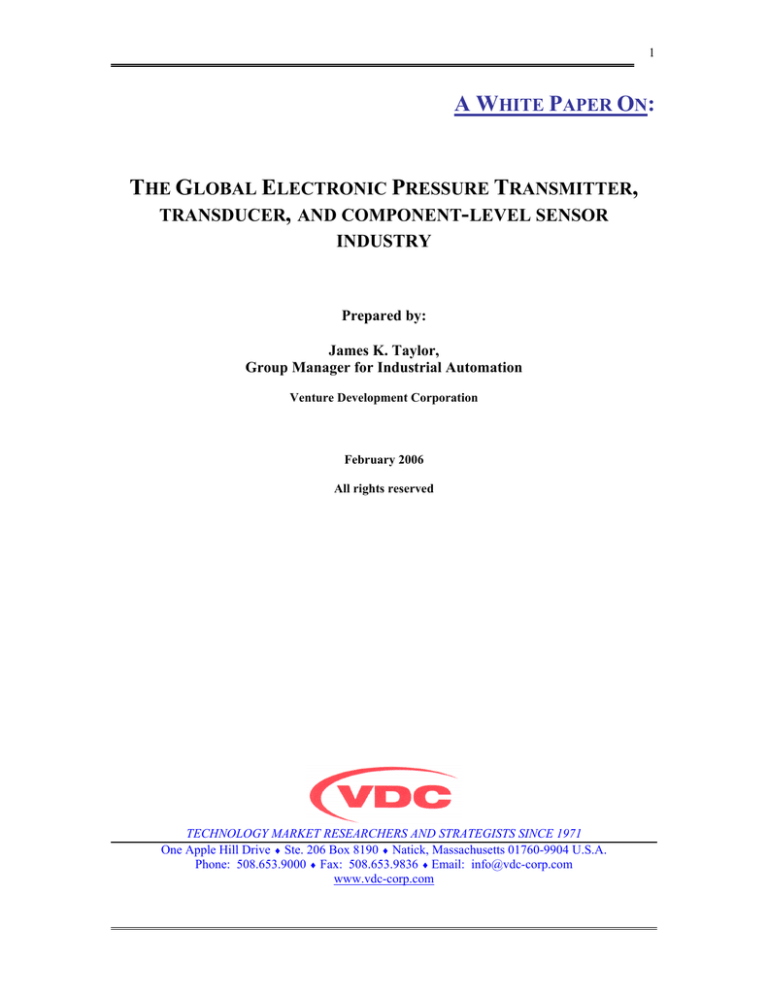
1
A WHITE PAPER ON:
THE GLOBAL ELECTRONIC PRESSURE TRANSMITTER,
TRANSDUCER, AND COMPONENT-LEVEL SENSOR
INDUSTRY
Prepared by:
James K. Taylor,
Group Manager for Industrial Automation
Venture Development Corporation
February 2006
All rights reserved
TECHNOLOGY MARKET RESEARCHERS AND STRATEGISTS SINCE 1971
One Apple Hill Drive ♦ Ste. 206 Box 8190 ♦ Natick, Massachusetts 01760-9904 U.S.A.
Phone: 508.653.9000 ♦ Fax: 508.653.9836 ♦ Email: info@vdc-corp.com
www.vdc-corp.com
2
This white paper highlights findings of a study completed by Venture Development Corporation (VDC) in
January 2006. The detailed study findings are contained in three volumes, one each for:
•
•
•
Electronic Process Pressure Transmitters
Electronic Non-Process Pressure Transmitters & Transducers
Electronic Component-Level Pressure Sensors
These three volumes focus exclusively on electronic pressure transmitters, transducers, and componentlevel sensors that provide an electronic output signal proportional to the pressure being measured. Products
that do not meet this definition and were specifically excluded included:
•
Pneumatic pressure transmitters where the output is a pneumatic pressure signal rather than an
electronic signal.
•
I/P transducers.
•
Pressure gauges and all other types of indicating-only pressure instrumentation.
•
Pressure switches.
•
Pressure recorders, controllers, alarms, and vacuum gauges.
Manometers, deadweight testers, pressure regulators, and all other mechanical pressure
measurement devices.
On the surface, the distinction between pressure transducers and transmitters should be clear:
•
Pressure transducers convert an unknown input pressure into low-level electrical/electronic
signals that would be grossly distorted if transmitted over long distances. The millivolt output
signals in a strain gauge pressure transducer are representative of this class of device.
•
Pressure transmitters are instruments that incorporate an electronic amplifier and the pressure
transducer into one package so that measurement data can be sent long distances without loss
of accuracy or introduction of electrical noise. For use in the process industries, transmitter
output signals typically conformed to a 4 to 20 mil-ampere standard, but increasing shipment
shares are smart transmitters that provide digital signals using various digital communication
protocols.
Prior to advances in integrated circuit technology, pressure transmitters were readily distinguishable from
transducers by bulky sizes, measuring from five to ten inches in each direction. Most pressure transducers
were far smaller. Today, miniature solid-state pressure-sensing devices containing integrated circuit
amplifiers are readily available for incorporation into pressure transducers. Furthermore, with widespread
factory and industrial automation, many pressure transducer outputs are transmitted over relatively long
distances, and the transducer often incorporates the 4-20mA or other standard output capabilities for this
purpose. Thus, long distance transmission of output signals is no longer limited to the process industries.
For the most part, however, there is still a significant difference between a pressure transmitter designed for
use in the process industries and a transducer/transmitter designed for use in other applications. Therefore,
VDC distinguishes these segments of the industry by using the term “process pressure transmitter” as
differentiated from “non-process pressure transmitters & transducers.”
In addition to these products, VDC also uses the term “component-level pressure sensor” to identify those
solid-state pressure sensors that are sold either as chips or with a limited degree of packaging that would
allow these to be incorporated into a transducer or transmitter. Again, the distinction can become blurred
because some monolithic chips contain significant degrees of sophisticated circuitry for temperature
correction, signal amplification and the like. However, it is still useful to identify these as a separate and
distinct part of the total electronic pressure sensing industry.
3
MARKET SIZE AND GROWTH
The combined global market for these products exceeded $US 4 billion in 2005, and is forecast to reach
almost $US 5.4 billion in 2010, increasing at a Compound Annual Growth Rate (CAGR) of 6.0%. Year
2005 shipments, and year 2010 shipment forecasts for the three product classifications are shown in Exhibit
1.
Exhibit 1
Current and Forecast Worldwide Shipments of Electronic Pressure-Sensing Devices
(US Dollars in Millions)
3500
3000
3031.0
2500
2000
2098.7
1500
2161.0
1689.0
1000
500
0
179.0
257.0
Component-Level Sensors
Process Transmitters
Non-Process Transmitters &
Transducers
VDC studied only the merchant market for the electronic component-level pressure sensors. Most
suppliers of pressure transducers and transmitters that use silicon chip technology produce these for their
own use, and this captive portion of the market is much larger than merchant market shipments. Though
the merchant market for these products is small, it is forecast to have a 7.5% CAGR through 2010, a rate
which is higher than that projected for the non-process pressure transmitters & transducers (at 7.0%), and
process transmitters (at 4.4%).
Many factors will influence growth in these product markets including:
•
•
•
•
•
Competitive pressure on prices
Displacement of other technologies in applications
Elimination of applications – entirely or by other technologies
Increasing automation/instrumentation of a wide variety of products/equipment for which pressure
sensing is needed
Levels of growth and maturity in geographic and industry/application markets
4
•
•
•
•
•
•
•
Make/Buy decisions of electronic pressure transmitter and transducer manufacturers regarding
component level sensors for these
Modernization and retrofitting of industrial plants
New applications
New product/equipment features and increased performance
New product/equipment introductions requiring new processes
Overall expansion of economies
Replacement of older mechanical technology pressure transmitters and transducers in applications
Multi-Variable Transducers and Transmitters
Multi-variable pressure-sensing devices combine a pressure output with one or more other types of sensing
output (most typically temperature) in one unit. These accounted for a small share of electronic pressure
transducer and pressure transmitter shipments to U.S. markets in 2005, at $US 217.8 million of a $US
3,850 million market, or 5.7% of the total (see Exhibit 2).
Exhibit 2
Current and Forecast Worldwide Shipment Shares of Multi-Variable Pressure Transmitters & Transducers
(Percent of US Dollar Volumes)
2005 Total: $US 3850.0 Million
MultiVariable
Type
5.7%
Pressure
Output Only
94.3%
2010 Total: $US 5129.7 Million
MultiVariable
Type
8.9%
Pressure
Output Only
91.1%
However, the growth rate in shipments of these products is expected to be much higher than the industry
average, with shipments expected to reach $US 454.5 million of a $US 5,129.7 million market in 2010, or
8.9% of the total. This represents a compound annual growth rate (CAGR) of 15.8% over the period,
compared to 5.9% for the overall market.
Multi-variable pressure transmitters and transducers allow users to reduce the total number of sensors by
replacing multiple units with one unit. This can result in:
•
•
•
•
•
Cost savings
Easier diagnostics
Fewer cables
Less weight
Reduction of size
5
There can be cost savings in lower prices than in purchase of two or more devices, and lower costs after
purchase (lower installation/wiring costs, lower maintenance costs, etc.). Other advantages cited are higher
reliability, easier calibration, and reduction in process intrusion/penetration.
Increasing complexity of applications, with requirements for multiple sensing functions, will drive demand.
However, the need for these sensing function are not always at the same location, and this will limit
demand. Furthermore, with multifunction sensing in one package, if one sensor fails, a more expensive
sensor unit has to be replaced. This also will tend to limit growth in demand for these products.
Displacement of Transducers
There is an ongoing shift in displacement of electronic pressure transducers in some applications by
transmitters. Transmitters provide amplified outputs and eliminate or reduce the need for additional
interface/amplification electronics, and can provide better performance. Moreover, choosing transmitters
rather than transducers is becoming more attractive as the price premiums for these have been narrowing, a
trend that is expected to continue.
In 2005, estimated worldwide shipments of electronic pressure transmitters for non-process applications
was $US 864.4, with shipments forecast to increase at a 7.4% CAGR, reaching $US 1235.2 million in
2010. Worldwide shipments of electronic pressure transducers are forecast to increase from $US 1,296.6
million in 2005 to $US 1,795.8 million in 2010, at a slower 6.7% CAGR.
Smart Process Pressure Transmitters
The ongoing trend in the process pressure transmitter market is to smart product types with digital
communication interfaces. Shipments of traditional analog output types are expected to continue to decline
over the forecast period. The principal reason for this trend is the shift to digital networking in facilities,
thus eliminating much wiring. However, other benefits become available with the inclusion of intelligence
in the transmitters – such as self calibration, remote calibration and ranging, and self diagnostics.
In 2005, the HART communication protocol was provided with the majority of worldwide smart process
pressure transmitter shipments. HART is expected to still account for the dominant shipment share in 2010,
however, with a somewhat lower share as other buses/networks become more popular. In addition to
HART, declines in shipment shares of proprietary protocols, such as Yokogawa’s “Brain” and Honeywell
DE, are expected as vendors increase offerings of transmitters equipped with open protocols such as
Foundation Fieldbus, and Profibus, and as these gain acceptance among users.
It is also expected that wireless Ethernet connectivity will begin during the forecast period, and that this
communication technology will account for a small share of shipments in 2010.
Sensing Technologies
Many different types of sensing technologies are use in electronic pressure transducers and transmitters.
These include:
Piezoresistive (Strain Gauge) Types:
Bonded Foil
Bonded Rod
Bonded Wire
Semiconductor:
Bonded
Diffused
Ion Implanted
Silicon-on-Insulator
Silicon-on-Sapphire
Silicon-on-Silicon
6
Thick Film
Thin Film
Other Types:
LVDT (Linear Variable Differential Transformer)
Optical/Fiber Optic
Piezoelectric
Potentiometric
Resonant Solid State
Solid State Variable Capacitance
Variable Capacitance
Variable Reluctance
Vibrating Diaphragm, Cylinder, Wire
Vibrating Quartz Crystal
In the process electronic pressure transmitter market, five technologies – variable capacitance, resonant
solid state, and piezoresistive silicon-on-silicon, ion-implanted semiconductor and diffused semiconductor
devices – accounted for $US 1,546.3 million of 2005 worldwide shipments, or almost 92% of the total.
Among the major technologies used in process transmitters, the highest shipment growth rate forecasts are
for resonant solid state and piezoresistive silicon-on-silicon products.
In the non-process electronic pressure transmitter & transducer market, the top three technologies –
piezoresistive ion-implanted semiconductor, variable capacitance and piezoresistive diffused
semiconductor – combined to account for most of worldwide shipments in 2005.
In this market, the highest shipment growth rate forecasts are for technologies making up lesser shares of
the market, namely thick film piezoresistive, silicon-on-insulator piezoresistive, fiber optic, and silicon-onsilicon piezoresistive products.
In the worldwide component-level electronic pressure sensor market piezoresistive ion-implanted
semiconductor products comprised the bulk of the market in 2005, accounting for 68% of shipments. The
highest growth rates are forecast for two of the smaller product markets, piezoresistive thin film and
silicon-on-insulator semiconductor types.
As vendors seek to meet customer demands and differentiate themselves from competitors, they will
develop and expand offerings of new and different technologies for these markets.
The choice of one sensing technology over another can be a result of many factors, including:
•
•
•
•
•
•
•
Cost
Long-term stability
Performance, such as accuracy, sensitivity, and thermal drift
Pressure and temperature ranges where useable
Ruggedness
Size
Weight
Each technology tends to have certain strengths and weaknesses in regard to these and other factors.
Because of the multiple factors involved, the choice or offering of a particular sensing technology is often
application dependent. Furthermore, the choice often will be more the selection of a vendor based on many
more considerations than the sensing technology used.
7
Consuming Industries and Applications
Electronic Process Pressure Transmitters-In 2005, the majority of worldwide electronic process pressure
shipments were for use in chemical/petrochemical and oil/gas industry applications. The shipment growth
rate for chemical/petrochemical industry applications is expected to be below the industry average over the
forecast period, with an above-average growth rate for the oil/gas industry.
The highest market growth rate is expected for the much smaller primary metals market segment. The
largest dollar volume gain expected in 2010 versus 2005 is for the oil & gas segment, followed closely by
the chemical/petrochemical segment. Together these are expected to account for 51.5% of the total market
gain.
Factors contributing to the relative growth rates for all the industry market segments include:
•
•
•
Expected level of facilities to be built or upgraded
Pace of automation introduction in facilities
Pace of R&D and utilization of new technologies in facilities
Electronic pressure transmitters are used extensively for flow and level measurements across most of the
process industries. In 2005, flow measurement accounted for 37% of worldwide process electronic pressure
transmitter shipments, and level measurement for almost 33%. High majorities of these products were
differential pressure measurement devices. The worldwide shipment share for use in flow measurement
applications (mainly for differential pressure flowmeters) is expected to decline, as these are displaced in
applications by other flowmeter technologies.
Electronic Non-Process Pressure Transducers & Transmitters-Consuming markets for these products
are very diverse, spanning a broad range of applications. However, the market also is concentrated. The
automotive vehicle and medical equipment markets, the two leading segments, combined to account for
47.4% of the total in 2005. The medical market is forecast to increase at the overall average growth rate,
while the growth rate for the automotive vehicle market is forecast to be below average.
The highest shipment growth rate is forecast for plastic manufacturing equipment. The largest dollar
volume gain expected in 2010 versus 2005 is for the automotive vehicle applications. This segment is
expected to account for 31.3% of the total market gain.
Automotive vehicle applications are many, and these are increasing all the time. Typically in automotive
applications, usage of pressure measuring devices starts out as part of options on high-end vehicles, and
these options later become available on lower end vehicles. Some such usages remain as options, while
others become standard on vehicles.
Electronic Component Level Pressure Sensors-The merchant U.S. market for these products is heavily
concentrated in medical and automotive vehicles applications. A major portion of the medical market is to
suppliers who package these as catheter disposable invasive blood pressure monitors. Beyond these two
markets there is a large drop-off in shipment shares, with none of the remaining applications accounting for
a much as 8% of the total.
The medical equipment application segment is forecast to have the highest growth rate between 2005 and
2010. However, the larger automotive vehicle segment is expected to contribute a greater dollar volume
growth. It should be noted that most of the larger suppliers of pressure transducers & transmitters for
automotive applications produce their own electronic component level sensors, but there are other suppliers
who source these.
8
CHANNELS OF DISTRIBUTION
Electronic Process Pressure Transmitters
Vendor sales personnel account for the largest shares of electronic process pressure transmitter sales, both
worldwide, and in each of the major geographic regions. In 2005, their highest share was in the EMEA
(Europe, Middle East and Africa) region, with the lowest share being in North America (Canada and the
United States).
The largest 2005 electronic process pressure transmitter sales shares were to end users for all the major
geographic regions. The second largest shares were to OEMs, except for the Asia-Pacific region where
consulting engineering/construction firms accounted for the second largest share.
Electronic Non-Process Pressure Transmitters & Transducers
Vendor sales personnel account for the largest shares of these sales, both worldwide, and in each of the
major geographic regions. In 2005, their highest share was in North America, with the lowest share being
in Latin America (Mexico, Central and South America).
Sales shares between company sales personnel and manufacturers’ representatives vary by application
markets served. Typically, markets where there tend to be large accounts (such as for automotive vehicles,
medical use, and computer peripherals) are more often served by company sales personnel than other
markets (such as for industrial applications), where accounts tend to be smaller.
In 2005, the largest sales shares were to OEMs in all the major geographic regions. The second largest
shares in all regions were to end users. Sales through distributors and to others accounted for much smaller
shares in all the regions. Sales shares by customer classes also vary considerably for the different
application segments. Not surprising, a large share of sales are to OEMs for automotive vehicle
applications. In contrast, a large share of sales is to end users for medical applications. Much of this market
consists of disposable blood pressure monitors, and sales are principally to hospitals, or their buying
organizations. In general, the shares of sales through distributors are above the overall market average for
products going into industrial applications.
Electronic Component Level Pressure Sensors
Vendor sales personnel account for the majority of worldwide component level electronic pressure sensor
sales, however, their share varies by region. In 2005, the shares by manufacturers’ representatives and
agents were considerably higher in Latin America and North than in the Asia-Pacific and EMEA regions.
The vast majority of these products are sold to OEMs, including manufacturers of electronic pressure
transmitters and transducers for their products. A small share of worldwide sales is through distributors,
with other customer classes accounting for fractional shares.
USER NEEDS
Product Selection Criteria
VDC asked users (end users, OEMs, and systems integrators) to identify the most important product
features and specifications in their selection of these products. Those most identified are shown in Exhibit
3.
9
Exhibit 3
Product Specifications and Features Identified as Most
Important in Selection of Electronic Pressure Sensing Devices
(Rankings on Basis of Percent of Users Identifying Criteria)
Ranking
1
2
3
4
5
Process
Transmitters
Accuracy
Reliability
Durability/
Ruggedness
Ease of Calibration
and Ranging
Repeatability &
Temp. Stability
Non-Process
Transducers/
Transmitters
Component
Level
Sensors
Accuracy
Reliability
Durability/
Ruggedness
Repeatability
Accuracy
Reliability
Repeatability
Temperature
Stability
Temperature
Stability
Small Size
Other criteria identified by fewer of the users included:
Communication Protocol
Diagnostic Capabilities
Ease of Maintenance
Flexibility/Ranging
High Temperature Capability
High Vibration Capability
Interchangeability
Linearity
Prognostic Capabilities
Response Time
Sealed Connectors-to protect sensors, and for rupture leakage protection
Weight
Note: This table addresses only product and feature selection criteria. Non-product or “commercial”
vendor selection criteria (such as price, deliver, application support, service, etc.) are treated separately in
the study.
Rankings were found to vary by industries and applications. It is interesting, however, that the top five
rankings overall are the same as we found in a 2002 market study on these products. In addition, the
rankings of the top five for each are the same for the electronic process pressure transmitters, and electronic
non-process pressure transmitters & transducers, and the same for the top two for the electronic
component-level pressure sensors.
The VDC reports further analyze the product selection criteria in some of the market segments where the
products are used. The following is a summary of these findings:
Consuming Markets for Electronic Process Pressure Transmitters-Analysis was made for users in the
chemical/petrochemical, electric power, oil/gas, and municipal water/wastewater industries.
For all four industries, accuracy was the most cited criterion. Reliability was identified by the second
largest share of users for all industry segments except oil/gas, for which diagnostic capabilities,
durability/ruggedness, and ease of calibration/ranging were cited by more of the users.
The largest difference in the responses for the individual industries and overall was 75% of those in the
oil/gas industries identifying diagnostic capabilities versus 31% overall. Those identifying diagnostic
10
capabilities were also much higher for the chemical/petrochemical and municipal water/wastewater
industries at 60% and 50% respectively. The harshness of these environments and/or remoteness of
locations are likely reasons.
Consuming Markets for Electronic Non-Process Electronic Pressure Transmitters and TransducersAnalysis was made for users having automotive vehicle, HVAC/refrigeration, medical, military/aerospace,
pneumatic/hydraulic, process control (for transducers only), pump, R&D laboratory, and test/measurement
applications.
Accuracy was the most cited criteria in seven of these nine application markets. In the two markets where
not cited the most, HVAC/refrigeration and pumps, this criterion was identified second and third most by
users, respectively.
Of the major application segments under study, users in the automotive vehicles and military/aerospace
markets identified the greatest number of selection criteria. In comparison, users of pumps had a generally
low level of selection criteria.
Consuming Markets for Electronic Component Level Pressure Sensors-Analysis was made for users
having medical, process control, R&D laboratory, and test/measurement applications.
Among these, reliability was the most cited product selection criterion for R&D laboratory and medical
applications, tied with accuracy as the most cited for test/measurement applications, and was second to
accuracy for process controls. Accuracy was the second most cited for R&D laboratory and medical
applications.
The largest difference in the responses for these applications and overall was for only 14% of those in
process controls identifying small size, versus 51% overall. Furthermore, the share identifying high
temperature capability was much higher for test/measurement versus that for all respondents, at 60% versus
26% respectively.
Vendor Non-Product Selection Criteria
The users also identified the most important non-product or “commercial” considerations in their selection
of electronic process pressure transmitter, non-process pressure transmitter & transducer, and component
level sensor vendors. Among the five most identified, four were common for all three product classes:
•
•
•
•
Availability
Competitive Prices
Delivery
Ease of Working With Vendor
Among the five most identified criteria was stability of the firm by the electronic process transmitter and
non-process transmitter & transducer users, and application support by the electronic component level
pressure sensor users.
Information Sources on Products and Vendors
Users learn about these products, and vendors through a variety of sources. Those most identified in the
VDC survey were:
•
•
•
•
•
Internet Search Engines & Web Sites
Product Literature of Vendors and Distributors
Sales Personnel
Seminars
Trade Periodical Ads and Articles
11
•
•
Trade Shows
Word of Mouth
However, no single source dominated the responses, suggesting that information is typically gathered by
multiple means.
COMPETITIVE ANALYSES
The following are brief discussions on the leading suppliers of the products studied. Detailed data on
shipments and market shares are contained in the reports. In addition, the reports contain sections on
perception of the vendors in the marketplace, and profiles of the more significant competitors. The profiles
include corporate overviews, shipments of the products studied, segmentation of shipments by sensing
technologies, manufacturing locations of these products, geographic distribution of shipments, industries
and application markets served, channels of distribution used, and strategic direction and outlook for the
firm in these industries.
Electronic Process Pressure Transmitters
•
Rosemount is the largest supplier in the overall process electronic pressure transmitter market, and
with second place Yokogawa Electric accounted for almost 63% of the total worldwide market in
2005.
•
Rosemount has the leading share in the smart process electronic pressure transmitter market segment
Yokogawa also has a significant share. Together they accounted for over 65% of this worldwide
segment in 2005.
•
Rosemount is the dominant supplier of traditional electronic process pressure transmitters. Nagano
Keiki was the only other supplier of these transmitters in 2005 with a greater than 10% worldwide
market share.
•
In 2005, Siemens accounted for more than half of global shipments in the small low-cost/nonrepairable market segment. Ashcroft and Honeywell Process Solutions were the only other suppliers
with greater than 10% shares. Together the three firms accounted for over 77% of the worldwide
market.
•
Vendors of process pressure transmitters concentrate on supplying one, or at most two types of sensing
technologies. Among the major sensing technologies, Rosemount dominated shipments of variable
capacitance and piezoresistive silicon-on-silicon products in 2005, while Yokogawa dominated sales of
resonant solid state products. Yamatake and Honeywell Process Solutions together accounted for 77%
of worldwide piezoresistive ion-implanted product shipments.
Electronic Non-Process Pressure Transducers and Transmitters
•
These products cover a wide range of applications, and the overall market has many suppliers. It is
fragmented with the largest supplier Delphi Electronics & Safety accounting for only 7.5% of the
worldwide total in 2005. The top five vendors combined to account for only 29.4% of the global
market.
•
Regarding market shares by sensing technologies, generally those segments with the larger dollar
volumes, such as ion-implanted semiconductor piezoresistive, variable capacitance and diffused
semiconductor piezoresistive, are more competitive. These technologies have the most competing
firms and the leading vendors have relatively low shares of shipments. Conversely, smaller segments,
such as for piezoresistive bonded wire, piezoresistive silicon-on-silicon and variable reluctance, have a
lower number of vendors offering these technologies, and are led by vendors with more dominant
shares.
12
•
In contrast to fragmentation of the overall market, the automotive vehicle application segment is quite
concentrated. In 2005, the top 6 suppliers, led by Delphi Electronics & Safety, accounted for 86.5% of
worldwide shipments for this segment. Among the top 5 suppliers all shipments were for automotive
vehicle applications, except for TI Sensors and Controls, for whom automotive applications accounted
for 90% of shipments. For 6th place Kavilico, automotive applications accounted for their largest share
of shipments at 35%.
•
In medical applications, six firms had greater than 5% market shares, and together accounted for
72.8% of this market segment. Among the 6 leading worldwide suppliers, four; Edwards Lifesciences,
Hospira, Integra Neurosciences, and the Argon Division of Maxxim supply only disposable blood
pressure-sensing transducers used with catheters. Integra Neurosciences specializes in only those for
inter-cranial use.
•
In the military/aerospace segment, led by Kulite Semiconductor Products, 7 firms had greater that 5%
shares, and together accounted for 66.9% of the worldwide market. Among these 7 firms, all or the
vast majority of their 2005 shipments were for military and/or aerospace applications. The exception
was Kavlico, which also serves many other market segments.
•
In the test & measurement application segment, four firms had 5% or greater market shares, and
together accounted for 62.8% of the total. The two leaders – AVL List and Kistler – accounted for over
47%. All the AVL List shipments were of piezoelectric transducers, and all were for test/measurement
applications. The principal applications were for automobile, industrial, truck, and off-road vehicle
combustion engines. In 2005, 50% of Kistler’s shipments were for test/measurement, with engine
monitoring being a major application. Kistler supplies pressure transmitters with piezoresistive
diffused semiconductor and bonded rod-sensing technology, and pressure transducers with quarts
crystal piezoelectric and piezoresistive diffused semiconductor technology.
Electronic Component Level Pressure Sensors
Freescale Semiconductor was the leading supplier of these products in 2005. In addition, three other firms,
GE NovaSensor, Intersema Sensonsoric, and Measurement Specialties had over 10% market shares, and
together they accounted for 56.8% of the worldwide merchant market in 2005. Three are U.S. companies,
and the fourth Intersema Sensoric is a Swiss firm.
For most of the sensing technology segments, shipments are dominated by one or two suppliers. For the
large piezoresistive ion-implanted semiconductor segment the three largest suppliers – Freescale
Semiconductor, GE NovaSensor, and Intersema Sensoric – combined to account for 65.2% of merchant
market shipments in 2005.
In the automotive vehicle market segment, Freescale Semiconductor had a large market share lead over GE
NovaSensor and Measurement Specialties, who had about the same market shares. These along with fourth
place Intersema Sensoric together accounted for almost 75% of the worldwide market for these applications
in 2005.
The three leading vendors – GE NovaSensor, Measurement Specialties, and Freescale Semiconductor –
accounted for 71.3% of the worldwide market for medical applications in 2005. Among the three leaders,
Measurement Specialties is the most focused on medical applications. These accounted for 45% of their
component level electronic pressure sensor shipments in 2005. For the leader, GE NovoSensor, medical
applications accounted for 40% of their shipments in 2005. Third place Freescale Semiconductor is less
focused on the medical market, and these applications accounted for 15% of their shipments of these
products in 2005.
The much smaller military/aerospace application market is dominated by Honeywell’s Solid State
Electronic Center (SSEC), although Intersema Sensoric has a significant market share. Together they
accounted for almost 80% of merchant worldwide shipment for this segment in 2005. For Honeywell
13
SSEC, military/aerospace applications accounted for 60% of their electronic component level electronic
pressure sensor shipments in 2005. Intersema Sensoric had 16% of their shipments for military/aerospace
applications.
The even smaller process control application market segment is more fragmented, although Honeywell
SSEC had a commanding market share lead in 2005. Six firms had over 5% market shares, and combined
to account for 73.6% of the worldwide merchant market. Among these leading vendors, GE Druck is most
focused on process applications. These accounted for 80% of their electronic component level electronic
pressure sensor shipments in 2005.
ABOUT THE STUDY
This white paper is a summary of findings from a VDC market study titled Global Markets for Electronic
Pressure Transmitters, Transducers, and Component-Level Sensors, Ninth Edition. Three report
volumes provide markets sizes, segmentation, and forecasts as appropriate by product classes, by sensing
technologies, by major geographic regions of the world, by consuming industries and applications, and by
channels of distribution.
The study includes results of an extensive investigation into user needs and perspectives regarding these
products. Included are findings relative to product and vendor selection criteria, and information sources
used to obtain data about these products and product vendors.
Vendor shipments and market shares are presented, overall, by classes of products, by sensing
technologies, in major geographic regions, and as appropriate for major application market segments.
Perception ratings and comments about the vendors obtained from users are presented. Detailed profiles are
presented on the more significant vendors in the markets, and detailed lists of vendors active in these
product markets are included.
Based on the study findings VDC presents in the reports recommendations on how suppliers to these
markets can enhance their competitive positions. These cover product features and performance, targeting
of industry/application markets, targeting geographic markets, channels of distribution, promotion, and
other success factors.
These reports are available for purchase in PDF files by E-mail, at prices of:
$US 5,450 for one volume,
$US 7,750 for two volumes, and
$US 9,350 for three volumes
Printed volumes are an extra $US 200 each.
STUDY SOURCE
Venture Development Corporation is a technology research and management consulting firm serving the
worldwide electronics industry. It was founded in 1971 by graduates of the Harvard Business School and
MIT. VDC offers in-depth market research, as well as custom strategic planning and consulting services in
the areas of industrial automation, instrumentation, electronic components, computers and peripherals,
communications, office equipment, and consumer electronics.
For further details contact Jim Taylor, Group Manager for Industrial Automation, or
Marc Regberg, Senior Vice President/COO; Phone: 508.653.9000, Fax: 508.653.9836
Email: jimt@vdc-corp.com, or msr@vdc-corp.com

